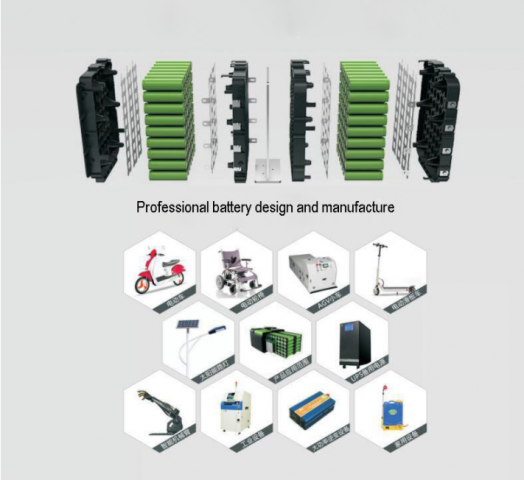There are many cases in which lithium ion batteries are used in series and parallel. The application battery formed by protecting the circuit, casing, and output is called PACK. PACK can be a single battery, such as mobile phone batteries, digital camera batteries, MP3, MP4 batteries, etc., or a series-parallel combination battery, such as laptop batteries, medical equipment batteries, communication power supplies, electric vehicle batteries, backup power supplies, etc.

Introduction of Lithium Ion Battery:
1. The working principle of lithium ion battery Lithium ion battery is a kind of concentration difference battery in principle, the positive and negative active materials can emit lithium ion intercalation and extraction reaction. The working principle of lithium ion battery is shown in the figure below: Lithium ion is active from the positive electrode during charging The material is removed from the material and migrates to the negative electrode via the electrolyte under the external voltage; at the same time, lithium ions are inserted into the negative electrode active material; the result of charging is the high energy state of the negative electrode in a lithium-rich state and the positive electrode in a positive lithium state.
The opposite is true during discharge. Li+ is released from the negative electrode and migrates to the positive electrode via the electrolyte. At the same time, in the positive electrode Li+ is embedded in the crystal of the active material, the flow of electrons in the external circuit forms a current, which realizes the conversion of chemical energy to electrical energy. Under normal charge and discharge conditions, lithium ions are inserted or extracted between the layered structured carbon material and the layered structured oxide, and generally do not damage the crystal structure. Therefore, from the perspective of the reversibility of the charge and discharge reaction, the charging and discharging of lithium ion batteries The discharge reaction is an ideal reversible reaction. The charge and discharge reactions of the positive and negative electrodes of a lithium ion battery are as follows.
2. Characteristics and applications of lithium batteries Lithium-ion batteries have excellent performance such as high working voltage, high energy density, long cycle life, low self-discharge rate, low pollution, and no memory effect. The specific performance is as follows:
a. The voltage of lithium-cobalt and lithium-manganese cells is 3.6V, which is 3 times that of nickel-cadmium batteries and nickel-hydrogen batteries; the voltage of lithium-iron cells is 3.2V.
b. The energy density of lithium-ion batteries is much larger than that of lead-acid batteries, nickel-cadmium batteries, and nickel-hydrogen batteries, as shown in the figure below, and lithium-ion batteries have the potential for further improvement.
c. Due to the use of non-aqueous organic solvents, the self-discharge of lithium-ion batteries is small.
d. It does not contain harmful substances such as lead and cadmium, and is environmentally friendly.
e. No memory effect.
f. Long cycle life. Compared with secondary batteries such as lead-acid batteries, nickel-cadmium batteries, and nickel-hydrogen batteries, lithium-ion batteries have the above advantages. Since they were commercialized in the early 1990s, they have developed rapidly and have continuously replaced cadmium in various fields. Nickel and nickel-hydrogen batteries have become the most competitive batteries in the field of chemical power applications. Currently, lithium-ion batteries have been widely used in portable electronic devices such as mobile phones, notebook computers, personal data assistants, wireless devices, and digital cameras.
The batteries used in military equipment, such as power supplies for underwater weapons such as torpedoes and sonar jammers, power supplies for micro unmanned reconnaissance aircraft, and power supplies for special forces support systems, can all use lithium-ion batteries. Lithium batteries also have broad application prospects in many fields such as space technology and medical treatment. As people’s awareness of environmental protection continues to increase and oil prices continue to rise, electric bicycles and electric vehicles have become the most dynamic industries. The application of lithium-ion batteries in electric vehicles is very optimistic. With the continuous development of new materials for lithium-ion batteries, battery safety and cycle life continue to improve, and the cost is getting lower and lower, lithium-ion batteries have become one of the first choice high-energy power batteries for electric vehicles.
3. The performance of lithium-ion batteries Battery performance can be divided into 4 categories: energy characteristics, such as battery specific capacity, specific energy, etc.; working characteristics, such as cycle performance, working voltage platform, impedance, charge retention, etc.; environmental adaptation Capabilities, such as high temperature performance, low temperature performance, vibration and shock resistance, safety performance, etc.; supporting characteristics mainly refer to the matching capabilities of electrical equipment, such as size adaptability, fast charging, and pulse discharge.
Media Contact
Company Name: Shenzhen Polymer Battery CO.,LTD
Email: Send Email
Phone: +86-755 36631197
Address:Floor 5, Building 6, Dongfanghong Industrial Park, Yushi Road, Guanlan
City: Long Hua, 518109
State: Shenzhen
Country: China
Website: https://www.plmen-battery.com/
